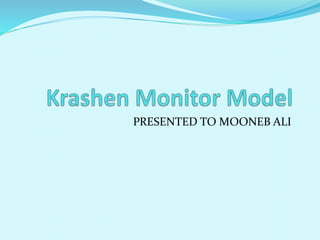
Krashen monitor model
- 1. PRESENTED TO MOONEB ALI
- 2. . KRASHEN
- 3. Group members Mohsina Ashraf Maria Rafique Nadia Neelam Sabahat Shahzadi
- 4. . CONTENT LIST 1. STEPHAN KRASHEN 2. KRASHEN’S MONITOR MODEL 3. THE FIVE CENTRAL HYPOTHESIS 4. VARIABLES CONCLUSION:
- 5. Background and Main Representative Staphen Krashen is an expert in the field of linguistics, specializtion in theories of language acquisition and development. Krashen’s widely known and well accepted theory of second language acquisition had a large impact in area of second language research and teaching since 1980.
- 6. Introduction According to Krashen’s acquisition learning hypothesis, there are two independent ways to develop our linguistic skills: acquisition and learning.
- 7. The Five Central Hypothesis . The acquisition-learning hypothesis The natural order hypothesis The monitor hypothesis The input hypothesis The affective filter hypothesis
- 8. The acquisition learning hypothesis Acquisition Learning Sub-conscious process Meaningful interaction Individual is not aware Natural way Conscious process Formal In the form of rules and grammar Less effective.
- 9. According to Brown: “Knowing a language rule does not mean one will be able to use it in communicative interactions”. (Brown,2000)
- 10. The acquisition learning hypothesis The process of internalizing new language, to storing this knowledge ,and to use it in actual performance.
- 11. .
- 12. Acquisition learning hypothesis Strength Language is learned through natural communication. Weaknesses Time consuming Learning formally is not an effective way.
- 13. . WHAT I AM TALKING ABOUT??
- 14. The natural order hypothesis The acquisition of grammatical structures follows a “natural order” which is predictable. English is perhaps the most studied language as far as natural order hypothesis is concerned.
- 15. The natural order hypothesis Human acquires language in only way ,by understanding messages or by receiving comprehensible input and learners improve and progress along “the natural order”.
- 16. The Monitor hypothesis The monitor hypothesis explains the relationship between acquisition and learning. “Conscious learning can only be used as a monitor or an editor”. (Krashen and Terrell 1983)
- 17. The monitor hypothesis Three specific conditions Time Focus on form Know the rule
- 18. The input hypothesis Input hypothesis is only concerned with acquisition not learning. Structure that is “a little beyond” where we are now. “Going for meaning” first. Speaking fluency cannot be taught directly. Provide comprehensible input.
- 19. The Input hypothesis Speaking is a result of acquisition and not its cause. If input is understood,and there is enough of it, the necessary grammar is automatically provided. (Krashen,1985,p.2)
- 20. .Strength and Weakness Strength The more comprehensible input, more L2 proficiency. Teaching methods are dependent on comprehensible input. Weakness Since not all of the learners can be at the same level of linguistic competence at the same time, we are unable to define the level of i andi+1. Grammar generalization(making errors)
- 21. The affective filter hypothesis Learners feelings or attitude as an adjustable filter that freely fairs , impress or block input necessary to acquisition. 3 kinds of variables that affect the filter. 1. Motivation high 2. Self-confidence high 3. Anxiety low
- 22. Strengths Teacher’s try to reduce learner’s negative feelings. Learners have higher competence when they receive comprehensible input.
- 23. .
- 24. Causative Variables Taken Into Account In The Monitor Model ROLE OF L1 APTITUDE ROUTINES AND PATTERNS INDIVIDUAL DIFFERENCES AGE
- 25. Aptitude The learner’s aptitude predicts how well he will perform on grammar-type tests that provide the right conditions for the operation of the Monitor
- 26. Role of the L1 The use of the L1 as a performance strategy. Learner falls back on his L1 when he lacks a rule in the L2. He initiates an utterance using his L1 and then substitutes L2 lexical items.
- 27. Routines and patterns The formulas play a performance role only by helping the learner to outperform his competence. Acquisition catches up with the routines and patterns; that is, the structural knowledge contained in the formulas is developed
- 28. Individual differences There is a variation in the rate and the extent of acquisition as a result of the amount of comprehensible input received, and the strength of the affective filter. Three types of monitor users: 1. Over-users. 2. Under-users. 3. Optimal-users.
- 29. AGE It affects the amount of comprehensible input that is obtained; younger learners may get more than older learners
- 30. Acquisition learning distinction Methodological: The acquisition-learning hypothesis is not acceptable, because it cannot be tasted in empirical investigation. When learnt knowledge is automatized through practice it becomes acquired. The monitor model is still a black box theory.
- 31. The monitor The only evidence for monitoring is trying to apply explicit rules. Critical faculty enables us to become critically aware of what we have created and hence allows us to control it. Monitoring is limited to syntax, but in fact learners and users have the ability to edit their pronunciation, lexis, and, perhaps most important all, their discourse.
- 32. Variability It proposes that the learner’s knowledge of the L2, which is reflected in variable performance, is best characterized in terms of two separate competences acquisition and learning. The kinds of performance that results from focusing on form and meaning are best treated as aspects of a single but variable competence which contains alternative rules for realizing the same meaning, in much the same way as does the native speaker’s competence.
- 33. CONCLUSION KRASHEN’s monitor model and five other hypothesis are a model of teaching for the learning of second language They all are based off of the natural way a first language is learned
